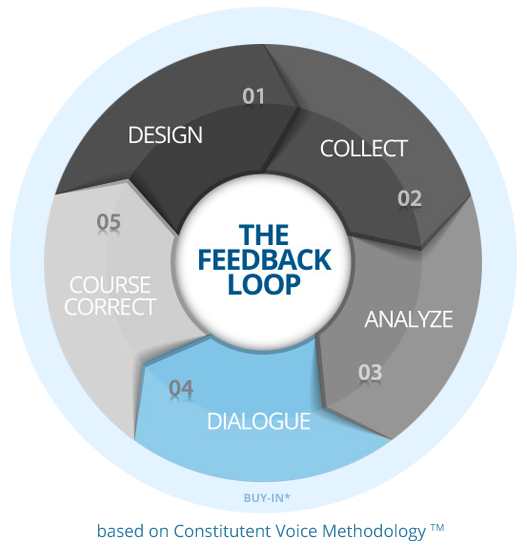Welcome to Feedback Fundamentals. In this series, we’ll be getting back to the basics and highlighting what it means to “close the loop.” Whether you’re well versed in the jargon or new to the feedback community, this series will introduce you to ideas, frameworks, tools and approaches that we believe are essential for a strong feedback practice. Feedback Fundamentals is all about building a strong foundation and realizing a vision of listening to the people you seek to serve.
Last time, we examined analyze – the step in which you look for patterns and information in the feedback data you’ve received. In this article, we examine the dialogue step.

Wow. At this point, your feedback loop is probably starting to feel pretty real. You’ve generated buy-in, you’ve designed a robust yet flexible process, you’ve collected feedback and you’ve analyzed it. Look at your analysis – so much information and insight! Now to use it. Onwards!
It can be tempting, in your eagerness to use the feedback you’ve collected and analyzed, to skip the next step in the loop: dialogue.
Dialogue is the step where you go back to the people from whom you’ve collected feedback and ask them what their feedback means.
Why would you do that? After all, you just analyzed the feedback for yourself. Well, as much as you might think you understand what the feedback you’ve collected is telling you, and what your analysis means, you’re probably missing some of what it means.
Take the experience of Our House, an Arkansas nonprofit, for example. As described in the video, the parents Our House seeks to serve gave them the feedback that they weren’t sure their kids were safe in Our House’s out-of-school programs. Our House staff weren’t sure how that could be – they had recently put all their staff through intensive child safety planning exercises. What did the feedback mean?
It was through dialogue with representatives of those parents that Our House realized that parents weren’t aware of all the safety planning and precautions Our House had recently taken. Through dialogue, they were able to understand that the feedback meant they should better communicate the steps Our House was taking. Now Our House describes their safety training in their parent-teacher conferences and initial on-boarding of new families.
Our House also takes its raw survey results to its Community Council, made up of current and former Our House clients. The Community Council reads and interprets the survey results and makes recommendations to Our House management and staff. Dialogue like that can often help you understand what the feedback you’ve collected means at a far deeper level than your analysis can. That’s not to say your analysis is not useful – in fact, presenting the patterns and ideas you’ve uncovered from your analysis can be a good way of starting the dialogue. One approach you can use is setting up a focus group of people who are representative of the people you seek to serve. You can share your analysis with them, and then let the discussion take off!
In addition to helping you understand what the feedback you’ve collected means, the dialogue step can also help the people you seek to serve feel that you’re really listening to their expertise.
That in turn can help them support your feedback processes, and perhaps even be more willing to give feedback the next time you ask for it. And even more importantly, it’s a way of sharing the power you have.
And finally, the dialogue step sets you up to take action based on the feedback you’ve received. Dialogue can help a group reach consensus about what should be done in response to the feedback. Sometimes you and the people you seek to serve will have different ideas about what you should do in response to feedback. Dialogue is about finding a middle-ground, and better solutions than you (or the people you seek to serve) could come up with on your own.
Next up: Tune in next as we tackle the final step of the loop: course correct.







